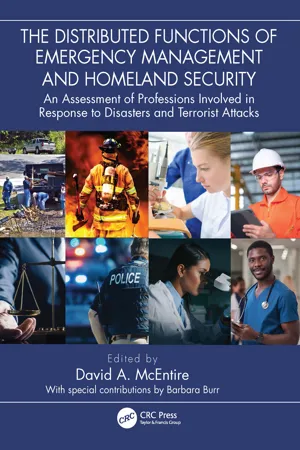
The Distributed Functions of Emergency Management and Homeland Security
An Assessment of Professions Involved in Response to Disasters and Terrorist Attacks
- 472 pages
- English
- ePUB (mobile friendly)
- Available on iOS & Android
The Distributed Functions of Emergency Management and Homeland Security
An Assessment of Professions Involved in Response to Disasters and Terrorist Attacks
About this book
The Distributed Functions of Emergency Management and Homeland Security outlines the roles and responsibilities of various individuals and agencies involved in homeland security and all aspects of emergency management. Each chapter focuses on the practical and applied aspects of a range of public servants in various departments and the organizations that they represent.
Rather than presenting a theoretical exploration alone, the book examines the practical knowledge and hands-on skills related to various functions and how their decisions and actions play into the larger framework of safety and security —in the public, private and nonprofit sectors. Every professional has a unique and integral part to play in fulfilling their roles and obligations, whether it be in relation to prevention, mitigation, preparedness, response or recovery operations. Personnel that frequently come to mind in such scenarios include emergency managers, geographers and land-use planners, EMTs and paramedics, fire fighters, police officers, public health officials, nurses, public administrators, and public information officers. And while these individuals are integral to homeland security and emergency management, there are other professionals that also perform essential duties that—while they aren't first-to-mind—are vital to efforts relating to terrorism and disasters; this includes pilots in the aviation sector, the military, attorneys, psychologists, and forensic professionals serving in pathology, DNA, and dentistry roles.
Chapters provide a holistic rendering of the homeland security and emergency management landscape to present all these various professional capabilities and contributions. This includes how current functions are coordinated as well as how future efforts might change relative to a more proactive, all-hazards and holistic approach. As such, the book will be a useful resource for students and practitioners to understand the dynamic professions—and various disciplines and fields—that impact disaster and terrorism preparedness and response capabilities.
Frequently asked questions
- Essential is ideal for learners and professionals who enjoy exploring a wide range of subjects. Access the Essential Library with 800,000+ trusted titles and best-sellers across business, personal growth, and the humanities. Includes unlimited reading time and Standard Read Aloud voice.
- Complete: Perfect for advanced learners and researchers needing full, unrestricted access. Unlock 1.4M+ books across hundreds of subjects, including academic and specialized titles. The Complete Plan also includes advanced features like Premium Read Aloud and Research Assistant.
Please note we cannot support devices running on iOS 13 and Android 7 or earlier. Learn more about using the app.
Information
Table of contents
- Cover
- Half-Title
- Title
- Copyright
- Dedication
- Contents
- Contributor Biographies
- Foreword
- Preface
- Chapter 1 Disasters, Terrorist Attacks, and the Whole Community: A Preview of Professionals Involved in the Distributed Functions of Emergency Management and Homeland Security
- Chapter 2 The Role of the Emergency Manager in Disaster and Homeland Security: Navigating the Challenges of Intergovernmental Relationships through Networks
- Chapter 3 The Roles of Geographers and Land Use Managers in Emergency Management: Contributions Relating to the Space and Place of Hazards, Disasters, and Terrorist Attacks
- Chapter 4 Firefighters Protecting a Nation: Historical Perspectives and a Modern, All-Hazards Approach
- Chapter 5 Law Enforcement and Emergency Management: The Role of Policing during Disasters
- Chapter 6 Emergency Medical Services: A Diverse, Complex and Essential Profession for Disasters and Terrorist Attacks
- Chapter 7 Public Administration and Emergency Management: The Ties that Bind
- Chapter 8 Public Information Officer Functions in Emergency Management: Operating in Good Times and Bad
- Chapter 9 Professionals and Volunteers in Non-Profit Organizations: Understanding Their Vital Role and Impact in Emergency Management
- Chapter 10 Professionals in the Department of Homeland Security: The Swiss Army Knife of America’s Defense and Protection
- Chapter 11 The Role of Public Health in Emergency Management: Preparedness, Pandemics, Present and Future Challenges post-COVID-19
- Chapter 12 Disaster and Psychology: Preparation for, Response to, and Recovery from Terror
- Chapter 13 Aviation Tools for Emergency Management and Homeland Security: Types, Functions, and the Future of Aviation for Emergency and Disaster Response
- Chapter 14 Military Support for Civil Authorities Responding to Domestic Disasters and Emergencies: Limitations, Authorities and Capabilities
- Chapter 15 The Role of Law in Emergency Management and Homeland Security: Legal Foundations to Follow and Liabilities to Avoid
- Chapter 16 Healthcare Emergency Management: The Role of Relevant Professionals in Healthcare Systems, Facilities, and ESF8
- Chapter 17 Nursing and Disasters: Responding to Victim Needs and Performing Other Essential Functions
- Chapter 18 Forensic Technicians: Locating and Analyzing Physical Evidence in Terrorist Attacks
- Chapter 19 Forensic Pathology: Medicolegal Death Investigation and Management of Fatalities in Mass Disasters and Terrorist Events
- Chapter 20 The Role of Dentistry: Victim Identification in Mass Casualty Disasters
- Chapter 21 The Critical Role of Public Works in Emergency Management and Homeland Security: Promoting and Defending a Seat at the Table
- Chapter 22 The Information Technology Specialist: From Zero to Hero in Emergency Management and Homeland Security
- Chapter 23 Lessons about the Distributed Functions of Emergency Management: Individual Contributions, Interdependencies and Collective Recommendations
- Index